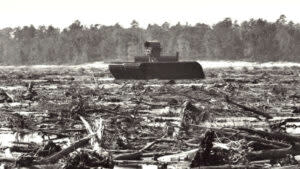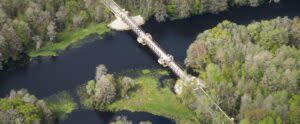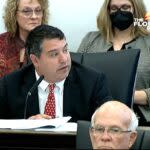DeSantis’ veto of Ocklawaha River rehabilitation study marks a first for the issue

Built in 1968, the Kirkpatrick Dam and Rodman Reservoir block the Ocklawaha River from flowing freely, via Florida State Parks.
Quality Journalism for Critical Times
Pens can be tricky. Once I was using one to write notes as fast as possible, trying to keep up with a former Monroe County judge telling me tales of Key West corruption, such as the one about a patrolman who got caught helping a crook drag a safe down the street. Suddenly, my pen exploded. It couldn’t handle the pressure.
The major risk when you use a pen is making a mistake. Unlike with pencils, you can’t just erase what you wrote and start over. The ink is permanent, so everyone can see what you’ve done.
Gov. Ron “I’m So Anti-Woke That I Snooze During Trump’s Rambling Speeches” DeSantis just learned that lesson. He used his special veto pen to slash funding for a study of credit card rates, but then it turned out his veto also eliminated 200 legislative support staff positions. His veto left legislative leaders scrambling to find funds to preserve those essential jobs.
He claimed later that this was NOT a mistake. But he sounded a lot like Pee-wee Herman falling off his bike and then springing up saying, “I meant to do that!”
What I want to tell you about is another bit of damage done by his veto pen. This little item that DeSantis canceled called for the state to spend $500,000 for an updated study of ripping out the decrepit old Rodman Dam and freeing the once wild and scenic Ocklawaha River.
The study, which was supposed to be done by the University of Florida Water Institute, “was intended to provide our state legislators current information so that they will be able to make an informed decision on the future of the dam,” said Jim Gross, executive director of Florida Defenders of the Environment. “The veto has once again kicked the can down the road.”
“It was an unwise veto,” said Estus Whitfield, who served as environmental adviser to Florida governors from both parties.
DeSantis’ decision flummoxed even the professor who would have been in charge of the study.
“All the people we had intelligence from said that it was good to go,” said Matthew Cohen, interim director of UF’s Water Institute.
No one has explained what went wrong, he told me. He didn’t hear from the governor’s office about why our chief executive slashed this expenditure like it was one of Michael Myers’ luckless victims in “Halloween.”
This might seem like a minor item compared to the massive size of our $116.5 billion budget, but consider the history involved. This veto puts DeSantis on the wrong side of Florida’s longest-running environmental wrangle.
“We had 40 years straight with seven different governors, four Democrats and three Republicans, who endorsed restoration of the Ocklawaha River,” Gross told me, rattling off the names that ran from Reubin Askew to Charlie Crist. “To my knowledge, neither Rick Scott nor Ron DeSantis have ever commented on restoring the Ocklawaha River.”
But at least neither of them had taken any action to oppose it — until now.
DeSantis is like lots of Florida politicians who try to convince the voters that they’re greener than a Kermit the Frog float in a St. Patrick’s Day parade because they spend taxpayer money on environmental projects.
But you can’t claim to care about Florida’s environment and then oppose freeing the Ocklawaha.
A mere Micanopy housewife
If we had a Hall of Fame for Bad Idea in Florida, this would be one of the opening entries.
The U.S. Army Corps of Engineers built what was originally known as the 7,200-foot-long Rodman Dam in 1968, halting the flow of the wild Ocklawaha River as part of the controversial Cross-Florida Barge Canal.
The canal was a project that had been discussed since the 1800s, when most commercial goods were delivered via ship, not by truck. Florida’s long peninsula required the ships to make a treacherous journey around the Keys. The canal would be a triumph of geometry over geography, giving barges a way to slice straight across the state.
Congress ordered the first study in 1826, and there was renewed interest in it as a make-work project during the Depression. But construction didn’t begin in earnest until 1964, with President Lyndon B. Johnson presiding at the groundbreaking in Palatka.
The Corps had won congressional approval for this boondoggle by inventing a bogus benefit that claimed that creating a huge ditch was a big improvement on the naturally wild landscape.
Then they launched a monstrous machine called the “Crusher-Crawler.” It squashed the cypress trees on some 9,000 acres of the Ocala National Forest. You can see how that made the land MUCH more attractive and valuable.
Meanwhile, a very determined woman was sounding the alarm about how wrong this project was. To make the canal deep enough to work, she warned, the Corps would have to cut down into the state’s aquifer. Seawater would turn our primary source of drinking water undrinkable, thus making Florida uninhabitable. Somehow the Corps was fine with that outcome.
This modern Cassandra was Marjorie Harris Carr, one of Florida’s three magical Marjories (the others being Marjory Stoneman Douglas and Marjorie Kinnan Rawlings). Canal backers sneered that she was “a mere Micanopy housewife.” She actually had a master’s degree in zoology and was married to the distinguished sea turtle biologist Archie Carr.
“Why fight for the Ocklawaha?” she asked once. “The first time I went up the Ocklawaha, I thought it was dreamlike. It was a canopy river. It was spring-fed and swift. … A lovely natural area, right in my backyard that was being threatened for no good reason.”
With a group of fellow scientists, she organized Florida Defenders of the Environment, which sued to stop the canal. In 1971 a federal judge issued an injunction stopping construction.
Three days later, President Richard Nixon halted construction, citing the potential for serious environmental damage. It was the largest public works project in American history to be stopped before completion.
The route that was supposed to become a canal became instead a 110-mile linear greenway for hikers, bikers, and horseback riders, named for Carr. But it was too late to stop the darn dam, a 7,200-foot-long structure which impounded 16 miles of the 80-mile river to create a 17,000-acre reservoir.
In addition to inundating a huge chunk of the national forest, the reservoir smothered 20 freshwater springs. Meanwhile, manatees can no longer migrate through the blocked river and sometimes wind up squished in the canal locks.
Carr fought for the rest of her life to restore the river. When she died in 1997, someone stuck a “Free the Ocklawaha” bumper sticker on her casket. Everyone vowed to continue her fight.
Yet, despite decades of effort, nobody’s been able to undo that dam.
All about that bass
Over and over, Florida governors have imitated Ronald Reagan at the Berlin Wall and called for tearing down the Rodman Dam. Over and over, some powerful legislator has thwarted the move by holding back the money like the little boy with his finger in the dike.
One, state Sen. George Kirkpatrick, was such a roadblock to progress that the dam is now named for him. (Note the irony: The Kirkpatrick Dam stands next to the Marjorie Harris Carr Greenway, so those life-long enemies remain yoked together today.)
Kirkpatrick has now departed the battlefield (with a bumper sticker on HIS coffin that said, “Save Rodman Reservoir!”), but his allies remain. I talked to current Save Rodman Reservoir president Steve Miller, who told me he’d had no idea DeSantis would veto the money, either.
“We’re thankful,” he told me, noting that DeSantis cut lots of what he considered wasteful spending with his vetoes.
When Miller first heard the money was in the budget, he said, “we shook our heads and said, ‘Really? Another study?’” He said that a lot depended on whether the study had been set up to be unbiased or whether it had a pre-ordained outcome.
He also contended the 56-year-old dam is “in sound condition, along with the locks.” In other words, no need to spend millions to replace it — at least, not yet.
Save Rodman’s main argument for keeping the dam in place is tied to all those tree stumps left by the Crusher-Crawler: They make the fishing really good.
Those dam fans dress this up in talk about the economic impact on Putnam County, where the reservoir is located, as well as adjacent Marion County. But as Meghan Trainor would say, “It’s all about that bass.”
“This is not just a Florida issue, because Rodman is an iconic bass fishery, people travel from all over the country to fish here,” one angler told Bassmaster Magazine in 2022.
Meanwhile, they throw up all sorts of horrible outcomes if the dam ever goes down. In one PowerPoint I’ve seen they even claim that removing the dam would threaten the greenway named for the dam’s most famous opponent.
When Ocklawaha advocates argue that the river would provide a similarly robust fishing and economic bonanza, the pro-fishery forces respond with, “You don’t KNOW that.”
Which is true. But if you pay attention to history, there’s a pretty strong indication from something that happened with another dam in Florida.
Resurrecting the Dead Lakes
The Rodman standoff always reminds me of what happened with the Dead Lakes, a 10-mile-long waterway in the Panhandle.
After a three-year drought kept the Dead Lakes too low for fishing, the Legislature approved building an 18-foot-tall dam on the Chipola River to boost fishing. It went up in 1960.
When the Dead Lakes Dam was new, fish corralled in the reservoir were much easier to catch than the ones in the free-flowing river. But over time, the lake filled with silt and weeds. Fish spawning beds disappeared. Soon the bass, bream, and shellcracker were so small they were hardly worth the bait to catch them.
Thus, state officials decided to tear down the dam. In 1987, a salvage contractor cut slots in the dam and removed it one section at a time, allowing the impounded lake to draw down slowly.
Fisheries biologists who studied the Dead Lakes found that, without the dam, the lakes were healthier. There were more fish and bigger fish. And there were twice as many kinds of fish as there used to be.
Somehow, though, this was not enough evidence to swing the votes in Tallahassee to rip out that more famous, and more contentious, dam.
Dam-olition dream deferred
The most recent comprehensive study of the Rodman Reservoir versus the Ocklawaha is from 1997, according to Cohen. That means it’s older than my oldest kid, who’s now an adult and gainfully employed in Jacksonville. It also means it’s way past time for an update.
The $500,000 appropriation for the UF study would have paid for “an updated, independent assessment of the science and economics of Ocklawaha restoration versus retention of the Kirkpatrick Dam and Rodman Reservoir,” the budget language says.
Of that, $200,000 would be for “development of planning-level cost estimates for restoration of the Ocklawaha River.”
The folks who want to keep casting their lines in the environmentally dam-aging reservoir can’t blame the party that’s been out of power for the past 20 years for this appropriation. The sponsor is a Republican: state Sen. Travis Hutson.
I’ve had issues with Sen. Hutson and his questionable bills in the past (he’s a developer, after all). But on this one piece of legislation, I’m counting him on the side of the good guys.
I put in calls to Sen. Hutson as well as lobbyist Andrew Ketchel, a former Department of Environmental Protection official who also worked on this issue. Neither returned my calls, perhaps because no one wants to be associated with something that’s been vetoed.
The bottom line, though, is that it seems unlikely anyone will try to bring it back up until Mr. Veto Corleone has moved on.
“DeSantis will eventually be term-limited out,” Gross said. “Hopefully, we will then get a new governor who will be responsive to the overwhelming majority of Floridians who support restoration of the Ocklawaha River.”
I tried asking DeSantis’ staff whether our boot-scootin’ chief executive meant to kill this study or if this was merely a slip of the pen (not that he’s ever done that). The communications office declined comment.
If he didn’t mean to do it, I have a suggestion for how he can fix it.
DeSantis can call a press conference next to the Rodman and announce that he’s issuing an executive order to immediately start the dam-olition and free the river. Then, to make it official, he can simply whip out his pen and sign his name.
But he should make sure to spell it right. It would be a shame if he messed up and wrote, “Dam-Santis.”
The post DeSantis’ veto of Ocklawaha River rehabilitation study marks a first for the issue appeared first on Florida Phoenix.








